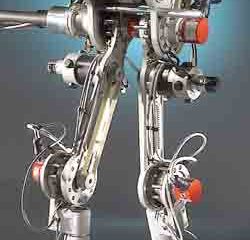This topic covers issues related to energy generation, conversion, transportation and consumption and how the industry is addressing the challenge of energy efficiency in general.
innovations-report provides in-depth and informative reports and articles on subjects ranging from wind energy, fuel cell technology, solar energy, geothermal energy, petroleum, gas, nuclear engineering, alternative energy and energy efficiency to fusion, hydrogen and superconductor technologies.

If you nudge this robot, it steps forward and catches its balance—much like a human
The machine called RABBIT, which resembles a high-tech Tin Man from “The Wizard of Oz,” minus the arms, was developed by University of Michigan and French scientists over six years. It’s the first known robot to walk and balance like a human, and late last year, researchers succeeded in making RABBIT run for six steps. It has been able to walk gracefully for the past 18 months.
U-

Technique could revolutionize nanoelectronics manufacturing
Carnegie Mellon University scientists have harnessed an experimental technology to produce polymer films with long-range-ordered nanostructure and easily convert them into highly ordered “nanocarbon arrays.” Called zone casting, this technology could revolutionize the way industrial nanoelectronic components are made. The research findings are in press with the Journal of the American Chemical Society. “We’ve found t

New devices may provide power for decades
Using some of the same manufacturing techniques that produce microchips, researchers have created a porous-silicon diode that may lead to improved betavoltaics. Such devices convert low levels of radiation into electricity and can have useful lives spanning several decades.
While producing as little as one-thousandth of the power of conventional chemical batteries, the new “BetaBattery” concept is more efficient and potentia

Penn State and Philips researchers have merged the best features of their respective approaches to produce a new mathematical model that describes the behavior of the MOS transistor in a wide class of integrated circuits found in the majority of electronic devices from computers to digital watches to communications systems.
Certain circuits can only be simulated accurately using the new approach, known as the PSP model, including passive mixers used in mobile phones to increase bat

In collaboration with KEMA, two postgraduate students from Eindhoven University of Technology have developed a device that continuously monitors cables to localize weak points in distribution networks. Data on weak point development and location enables an electricity company to pre-empt problems by timely intervention. This in turn enhances network reliability and reduces costs. With their invention, Jeroen Veen and Peter van der Wielen received in April their doctorate degree at the Eindhoven

Team members are former senior energy or security advisors in Democratic and Republican administrations from Carter to Clinton
MIT faculty members and colleagues, all former senior energy or security advisors in Democratic and Republican administrations from Carter to Clinton, have proposed a pragmatic plan that would allow the world to develop nuclear power without increased risk of weapons proliferation.
Under their plan, which appears in the winter 2004-2005 issu